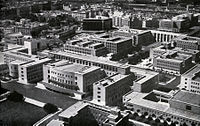Marcello Piacentini
Marcello Piacentini (8 December 1881 – 19 May 1960) was an Italian urban theorist and one of the main proponents of Italian Fascist architecture.

Biography
Born in Rome, he was the son of architect Pio Piacentini. When he was only 26, he was commissioned to revamp of the urban center of Bergamo (1907); subsequently, he worked in most of Italy, but his best works are those commissioned by the Fascist government in Rome.
Piacentini devised a "simplified neoclassicism" midway between the neo-classicism of the Novecento Italiano group (Gio Ponti and others) and the rationalism of the Gruppo 7 of Giuseppe Terragni, Adalberto Libera and others.[1] His style became a mainstay of Fascist architecture in Rome, including the new university campus (Università di Roma La Sapienza, 1932) and the E.U.R district, of which he was not only designer, but also High Commissar by will of Benito Mussolini. His other works include the renovation of Brescia and Livorno, the Museo Nazionale della Magna Grecia in Reggio Calabria, the opening of Via della Conciliazione in Rome, and the restoration of the Rome Opera House (1928–1958).
Piacentini became an important colonial architect, particularly in Cyrenaica in Eastern Libya. The style of his buildings is characteristic of the Neo-Moorish period of Italian colonial architecture in Libya in the 1920s. This is evident in his Albergo Italia as well as the Berenice Theatre in Benghazi. Piacentini was made project manager of all Italian building works in Cyrenaica.[2] He was also professor of Urban Planning at La Sapienza, of which he was also president. After the fall of the Fascist regime he did not work as architect for several years. He died in Rome in 1960.
Works


- Potenza, Progetto Ophelia (Ophelia Project), 1910
- Benghazi, Albergo Italia (Italia Hotel, known beforehand as Grande Albergo Roma) 1913 (along with architect Luigi Piccinato)[3]
- Benghazi, Benghazi Central Railway Station, 1916[3]
- Acqui Terme, Villa Ottolenghi, 1920, with Federico d’Amato, later Pietro Porcinai completed the villa and the park.[4]
- Benghazi, Interior of the City Hall, 1925
- Benghazi, Berenice Theatre, 1928[3]
- Bolzano Victory Monument, 1926–1928[5]
- Brescia, Piazza della Vittoria, 1927–1932
- Brescia, Torrione INA, 1930–1932
- Genoa, Arco della Vittoria, 1931
- Bolzano, Army Headquarters, 1933–1935
- Jerusalem, Generali Building, 1934–1935
- Reggio Calabria, Museo Nazionale della Magna Grecia, 1932–1941
- Rome, church of Sacro Cuore di Cristo Re, 1920–1934
- Rome, restore of Teatro dell'Opera di Roma, 1926–1928
- Rome, planning for Sapienza University of Rome campus, 1935
- Rome, Via della Conciliazione, 1936–1950, with Attilio Spaccarelli
- Zagreb, Assicurazioni Generali Building, 1937
- Rome, planning for EUR district, 1938–1942
- Rome, Albergo degli Ambasciatori (Via Veneto), 1925–1932
- São Paulo, Matarazzo Building, 1939
- São Paulo, Palácio dos Bandeirantes, 1938
- Rome, Teatro Sistina (1946–1949)
- Rome, Cappella universitaria Divina Sapienza (1947–1952)
- Ferrara, Nuovo Palazzo della Ragione (1954–1956)
- Rome, Palazzo dello Sport (1960), in collaboration with Pier Luigi Nervi
References
- ^ (in German) Luigi Monzo: trasformismo architettonico – Piacentinis Kirche Sacro Cuore di Cristo Re in Rom im Kontext der kirchenbaulichen Erneuerung im faschistischen Italien, in: Kunst und Politik. Jahrbuch der Guernica-Gesellschaft, 15.2013, p. 83-86.
- ^ ANMI Archive Rome "Girls Academy Benghazi" Archived 2014-12-27 at the Wayback Machine
- ^ a b c Longari, Elisabette (2011-03-15). "Revolution in Libya: if the war eradicates history". Domus. Retrieved 2018-03-11.
- ^ Alessio Guarino, Villa Ottolenghi. Pietro Porcinai, Marcello Piacentini, Federico d’Amato. Divisare, February 14, 2017
- ^ Obermair, Hannes (2017), "Monuments and the City—an almost inextricable entanglement", in Matthias Fink; et al. (eds.), 'Multiple Identitäten in einer "glokalen Welt"—Identità multiple in un "mondo glocale"—Multiple identities in a "glocal world", Bozen-Bolzano: Eurac Research, pp. 88–99, ISBN 978-88-98857-35-7
- Piacentini Marcello. Fascismo - Architettura - Arte / Arte fascista web site
Sources
- Lupano, Mario (1991). Marcello Piacentini. Rome-Bari: Laterza.
- Pisani, Mario (2004). Architetture di Marcello Piacentini. Le opere maestre. Rome: Clear.
- Scarrochia, Sandro (1999). Albert Speer e Marcello Piacentini: l'architettura del totalitarismo negli anni trenta. Milan: Skira.
- De Rose, Arianna S. (1993). Marcello Piacentini: Opere 1903–1926. Modena: Franco Cosimo Panini.
- (in German) Luigi Monzo, trasformismo architettonico – Piacentinis Kirche Sacro Cuore di Cristo Re in Rom im Kontext der kirchenbaulichen Erneuerung im faschistischen Italien, in Kunst und Politik. Jahrbuch der Guernica-Gesellschaft, 15.2013, pp. 83-100.
- (in German) Christine Beese, Marcello Piacentini. Moderner Städtebau in Italien. Berlin 2016.
- (in German) Luigi Monzo, Review to Beese, Christine: Marcello Piacentini. Moderner Städtebau in Italien, Berlin 2016. In architectura: Zeitschrift für Geschichte der Baukunst, 45.2015/1 (published October 2016), pp. 88-91.